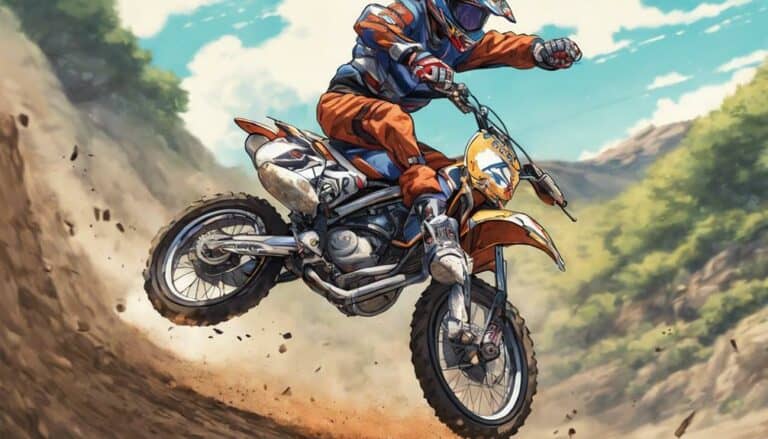When attempting a dirt bike wheelie, your feet act as the anchor on a ship, essential for maintaining stability and steering your course. But where exactly should you place them for best control and balance?
The position of your feet can make a significant difference in how smoothly you execute a wheelie and how well you can manage the bike's elevation. So, let's explore the intricacies of foot placement on a dirt bike during a wheelie to enhance your riding skills and conquer this thrilling maneuver with finesse.
Key Takeaways
- Secure top control and stability with feet on foot pegs for proper wheelie execution
- Position feet firmly on footpegs with toes angled outward for perfect balance
- Optimize stability and maneuverability by adjusting foot position with precision
- Experiment with different foot placements to enhance balance and control in dirt bike wheelies
Proper Foot Placement for Wheelie
When performing a dirt bike wheelie, secure top control and stability by firmly placing your feet on the foot pegs with toes pointed slightly outward. This position guarantees that you have a strong foundation to manage the bike's movements during the wheelie. By keeping your feet securely planted on the foot pegs, you establish a connection with the dirt bike that allows you to react quickly and adjust as needed.
Avoid the temptation to let your feet dangle or move around during the wheelie, as this can lead to a loss of control and potentially dangerous situations. By maintaining a consistent foot position on the foot pegs, you can focus on controlling the throttle and clutch smoothly, essential elements for a successful wheelie.
Practice proper foot placement consistently to enhance your balance and control while performing dirt bike wheelies. By mastering this foundational aspect, you set yourself up for improved performance and a more exhilarating riding experience. So, get out there, find your stance, and conquer those wheelies with confidence and skill!
Balancing Your Feet on Wheelie
To maintain perfect balance during a dirt bike wheelie, make sure your feet are positioned firmly on the footpegs with toes angled slightly outward. This stance helps you control the bike by allowing you to distribute your weight evenly between both feet.
As you lift the front wheel, focus on centering your weight and keeping a light touch on the footpegs. Balancing on the front fork requires precise movements; thus, avoid dragging your feet on the ground, as this can disrupt your balance.
By practicing shifting your weight from one foot to the other, you can make minor adjustments to stay upright. Remember to keep your eyes focused ahead and your body relaxed.
Adjusting Foot Position for Control
Position your feet on the foot pegs with precision and control to optimize your stability and maneuverability during dirt bike wheelies. When adjusting your foot position for control, make sure your toes are angled slightly outward on the foot pegs to enhance stability. By keeping your weight centered over the bike and using your lower body to help maintain balance, you can fine-tune your foot placement as needed during the wheelie. It's important to avoid extreme positions on the foot pegs, as placing your feet too far forward or backward can lead to loss of control and instability. Experiment with different foot positions to discover the most comfortable and effective stance for executing wheelies on dirt bikes.
| Adjusting Foot Position for Control |
|---|
| Toes angled slightly outward for stability |
| Keep weight centered over the bike |
| Use lower body for balance |
| Avoid extreme foot positions |
| Experiment for the most comfortable and effective stance |
Foot Techniques for Dirt Bike Wheelie
For best stability and control during dirt bike wheelies, make sure your foot placement on the foot pegs is precise and strategic. When going fast and attempting a wheelie, keep both feet firmly planted on the foot pegs if you're seated to maintain balance and control.
If you prefer standing wheelies, position your feet on the foot pegs with slightly bent knees for added stability. Advanced riders looking to control the height of the wheelie can use the rear brake with their right foot, adding an extra layer of finesse.
Remember to keep your weight centered over the bike to maintain control and adjust your foot positioning based on what feels most comfortable and effective for you. Experiment with different foot placements during practice sessions to find the most effective setup that enhances your balance and control, especially when you're pushing the limits and going fast.
Common Mistakes With Foot Placement
Placing your feet improperly during a dirt bike wheelie can greatly impact your balance and control, resulting in possible mishaps and challenges in maneuvering the bike. When it comes to foot placement, avoiding common mistakes is essential for a successful wheelie experience. Here are some key errors to steer clear of:
| Common Mistakes | Impact |
|---|---|
| Feet too far forward | Loss of balance and control, difficulty in steering |
| Feet too far back | Challenges in weight shifting and balance adjustment |
| Dangling feet off the bike | Risk of accidents, loss of stability |
To achieve a pretty good wheelie, ensure your feet are positioned correctly on the footpegs or slightly forward. By avoiding these missteps and practicing different foot placements, you can discover what works best for you, leading to smoother and more controlled wheelies. Remember, proper foot placement is key to mastering the art of dirt bike wheelies.
Conclusion
As you perfect your dirt bike wheelie technique, remember that your feet play an essential role in maintaining balance and control. Just like the foundation of a building supports its structure, your feet support your wheelie.
By placing them properly on the footpegs and adjusting your position as needed, you can soar to new heights with confidence and skill. Keep practicing, keep pushing your limits, and soon you'll be flying high like a soaring eagle.

